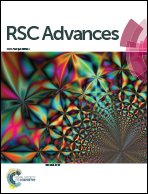Novel magnetic antimicrobial nanocomposites for bone tissue engineering applications†
Abstract
In the present study, we demonstrate the fabrication of novel bone-like magnetic nanocomposites by the blending of chitosan, polymethylmethacrylate-co-2-hydroxyethylmethacrylate, and nano-hydroxyapatite–Fe3O4. The hybrid nanomaterials were thoroughly characterized by Fourier transform infrared spectroscopy, powder X-ray diffraction and field emission scanning electron microscopy. The magnetic nanocomposites exhibited excellent mechanical properties (e.g. tensile strength, Young's modulus and stiffness) and antimicrobial activities. Hemolysis assays indicated that blood compatibility of the polymer sample is significant. Water uptake ability of the nanocomposite materials was found to increase with increasing the proportion of PMMA-co-PHEMA. In addition, the superparamagnetic nature of the nanocomposite was observed which makes these materials suitable for magnetic therapy.



 Please wait while we load your content...
Please wait while we load your content...